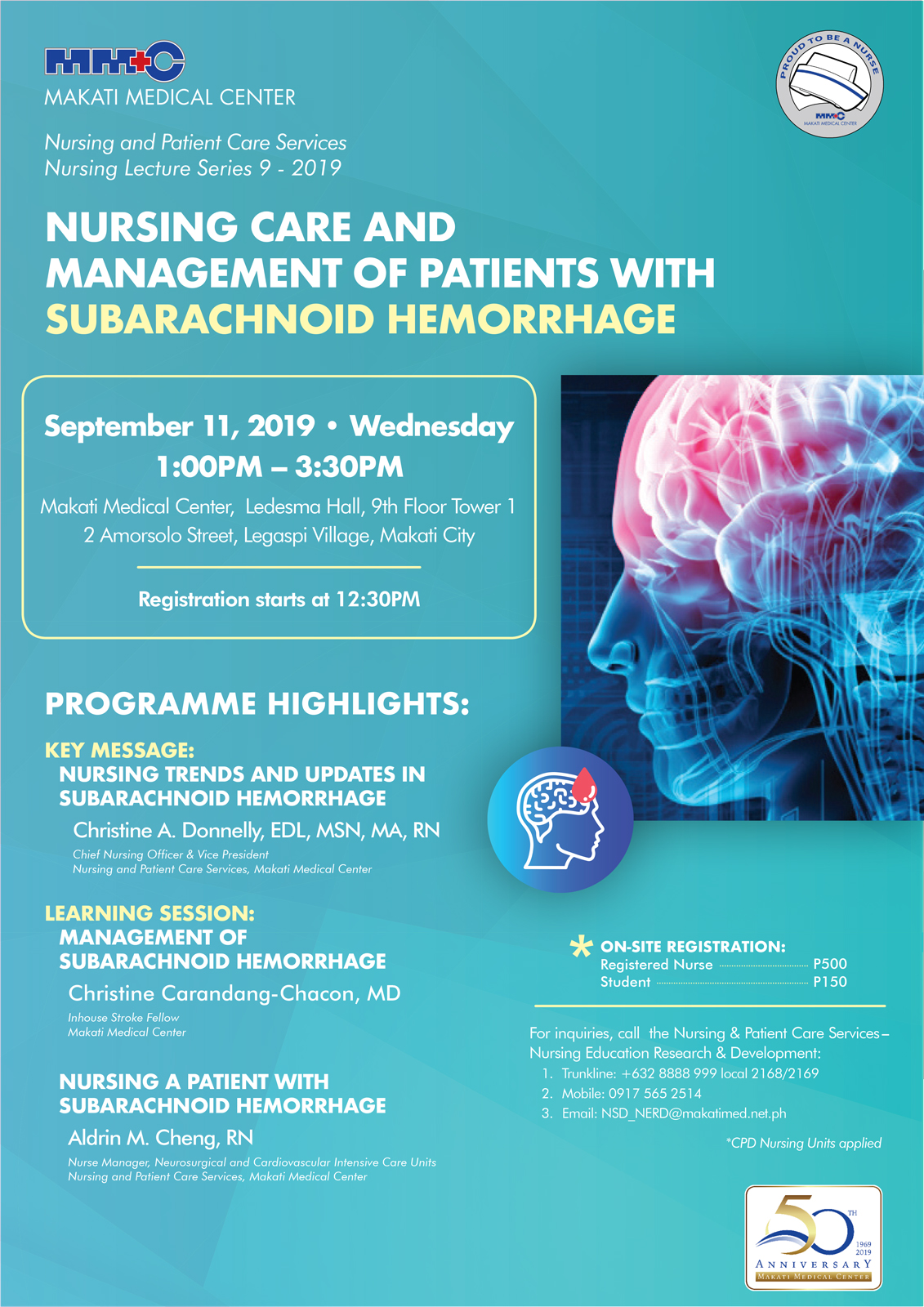Imagine waking up with a blinding headache, the worst you’ve ever experienced. It feels like something is splitting your skull open, and the pain radiates through your entire body. You’re rushed to the emergency room, and the doctors deliver a shocking diagnosis: subarachnoid hemorrhage, a type of stroke caused by bleeding in the space surrounding your brain. This diagnosis can be overwhelming, but it’s essential to understand that with proper care and a well-structured nursing care plan, recovery is possible.

Image: www.makatimed.net.ph
Subarachnoid hemorrhage (SAH) is a serious condition that occurs when a blood vessel in the space between the brain and its outer covering, the meninges, ruptures. This bleeding can put immense pressure on the brain, potentially leading to severe neurological damage. The implications of SAH can be devastating, affecting a person’s ability to think, move, and even speak. Therefore, a comprehensive nursing care plan becomes crucial for managing the immediate crisis and facilitating long-term recovery.
Understanding the Nursing Care Plan for Subarachnoid Hemorrhage
A nursing care plan for SAH is a detailed roadmap outlining necessary medical interventions and supportive care to optimize the patient’s recovery. This plan is tailored to individual needs and constantly evaluated to ensure effectiveness. It addresses the complex challenges associated with SAH, including:
1. Immediate Management:
- Maintaining Hemodynamic Stability: The first priority is to stabilize the patient’s blood pressure and heart rate. This involves managing blood loss, preventing further bleeding, and controlling blood pressure to protect the brain.
- Cranial Pressure Monitoring: Intracranial pressure (ICP) monitoring is a critical component, as increased pressure in the brain can lead to severe complications. Medications and mechanical devices may be used to reduce ICP.
- Airway Management: A secure airway is essential to ensure adequate oxygenation and prevent aspiration. This may necessitate intubation and mechanical ventilation.
2. Neurological Assessment and Monitoring:
- Frequent Neurological Checks: Regular assessments of the patient’s neurological status are crucial, including monitoring for changes in level of consciousness, pupillary response, motor function, and sensation.
- Neurological Imaging: Computed tomography (CT) scans and magnetic resonance imaging (MRI) are used to identify the location and extent of the bleeding, providing valuable information for guiding treatment strategies.
3. Pain Management:
- Medication Administration: Patients often experience severe headaches, and appropriate analgesics are prescribed for pain relief.
- Non-Pharmacological Techniques: Complementary methods like relaxation techniques, massage, and aromatherapy can also be incorporated to improve comfort and manage pain.
4. Prevention of Complications:
- Seizure Control: Anti-seizure medications may be necessary to prevent seizures, a potential risk following SAH.
- Hydrocephalus Management: If the bleeding causes fluid buildup in the brain (hydrocephalus), interventions like a ventriculoperitoneal shunt may be needed to drain excess fluid.
- Vasospasm Management: After SAH, blood vessels in the brain can narrow (vasospasm), reducing blood flow. Medications and other treatments are used to prevent or treat vasospasm.
5. Rehabilitation and Recovery:
- Cognitive and Physical Therapy: Patients may experience cognitive deficits and physical limitations, requiring specialized therapy to restore function. This might include speech therapy, occupational therapy, and physical therapy.
- Emotional Support: The emotional toll of SAH on both the patient and their family is significant. Support groups and psychological counseling can help patients and families cope with the challenges and anxieties associated with this condition.
Expert Insights and Actionable Tips
Expert Insights:
- Early identification and management are crucial for improving outcomes in SAH. The faster the intervention, the better the chances for preventing long-term neurological damage.
- Prevention is key. Lifestyle changes like managing high blood pressure and cholesterol, avoiding smoking, and limiting alcohol consumption can reduce the risk of SAH.
Actionable Tips:
- Stay informed: Educate yourself about the warning signs of SAH and seek medical attention immediately if you experience symptoms such as severe headache, sudden onset of nausea or vomiting, stiff neck, or loss of consciousness.
- Support your loved ones: If you have a family member or friend who has experienced SAH, offer them emotional support and encouragement throughout their recovery.
- Connect with resources: Join support groups and seek guidance from healthcare professionals and rehabilitation specialists to obtain the best possible care for yourself or your loved one.

Image: www.scribd.com
Nursing Care Plan For Subarachnoid Hemorrhage
Conclusion
Subarachnoid hemorrhage is a complex and challenging condition requiring specialized nursing care and sustained support. A comprehensive nursing care plan ensures the patient’s needs are addressed at every stage, from the initial crisis to long-term recovery. By understanding the critical components of this plan, individuals with SAH can make informed choices about their treatment and proactively engage in the recovery process. Remember, with expertise, dedication, and a strong support network, healing and regaining quality of life are achievable.
If you or a loved one is dealing with SAH, reach out to your healthcare provider to develop a personalized care plan and access critical support. This is not simply a medical journey; it’s a journey of resilience, hope, and the unwavering commitment of the dedicated nursing team.




